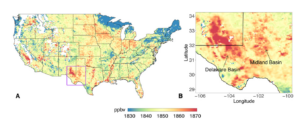
A new study published last week confirms what we already knew about oil and gas in the Permian Basin. It’s an unmitigated disaster.
The Permian Basin, located in West Texas and South East New Mexico, is one of the world’s most prolific oil and gas basins.
It is also where the unregulated drilling and fracking of tens of thousands of wells has led to what may be one of the greatest environmental crimes of the twenty-first century. In the rush to produce oil as quickly as possible, operators are spewing methane, along with various other hydrocarbon compounds, at an unprecedented rate.
That rate is so high, estimated at some 3.7% of production, or about 400 million cubic feet a day based on 2019 production figures, that the climate impact of burning Permian oil and gas is greater than burning coal.
The industry has always tried to downplay the excessive methane leakage in the basin, and the study’s authors appear to parrot the industry’s line on this. “(T)he high leakage rate in the Permian Basin appears to be associated with insufficient infrastructure for natural gas gathering, processing, and transportation.” In other words, if they could just build pipelines more quickly, this wouldn’t have to happen. But this does not tell the full story of what’s been going on in the Permian Basin.
The fact is that production has grown so fast, flooding markets and crashing prices, that the price of gas is less than the cost of processing it and transporting it to saturated markets. As regulators sign off on every waiver and exemption, producers flare and vent methane at will. Our friends at Earthworks have documented this time and again. Indeed, Oil Change staff traveled to the Permian in November 2019 and saw the mayhem for themselves. They spent some of their time travelling with the New York Times team that took these incredible images of methane leaking from site after site.
Now that COVID-19 has triggered the mother of all supply gluts, many believe that this problem may ease as production slows down in the basin. But this cannot be taken for granted. As companies cut costs they also cut corners. Monitoring by groups such as Earthworks is on hold while we try and flatten the curve. And as failing operators go bankrupt, their leaking well sites may go unchecked, spewing methane for months on end while their assets are held up in court proceedings.
It’s great that we now have more concrete figures for methane leakage in the Permian Basin. We know that the gas is no cleaner than coal and the oil is likely as dirty as the tar sands. But building more pipelines is not the answer. It never was, and it never will be.
For more insights into conditions on the ground in the Permian Basin, go here and here.
See these reports about the oil boom in the U.S. and in New Mexico.

